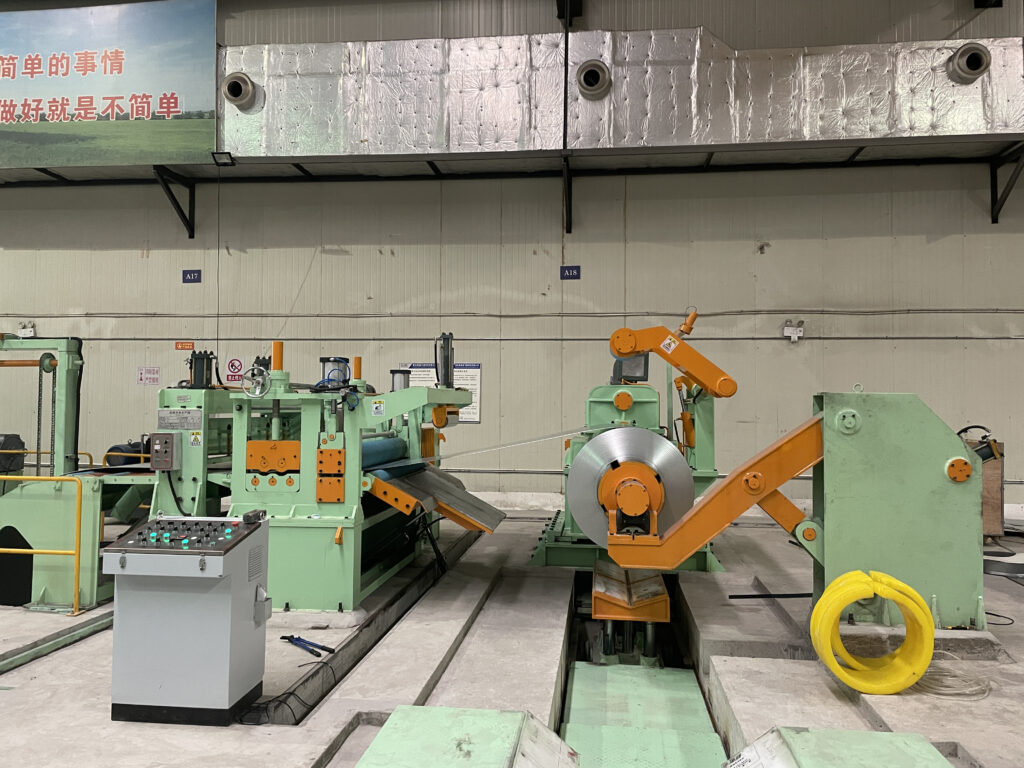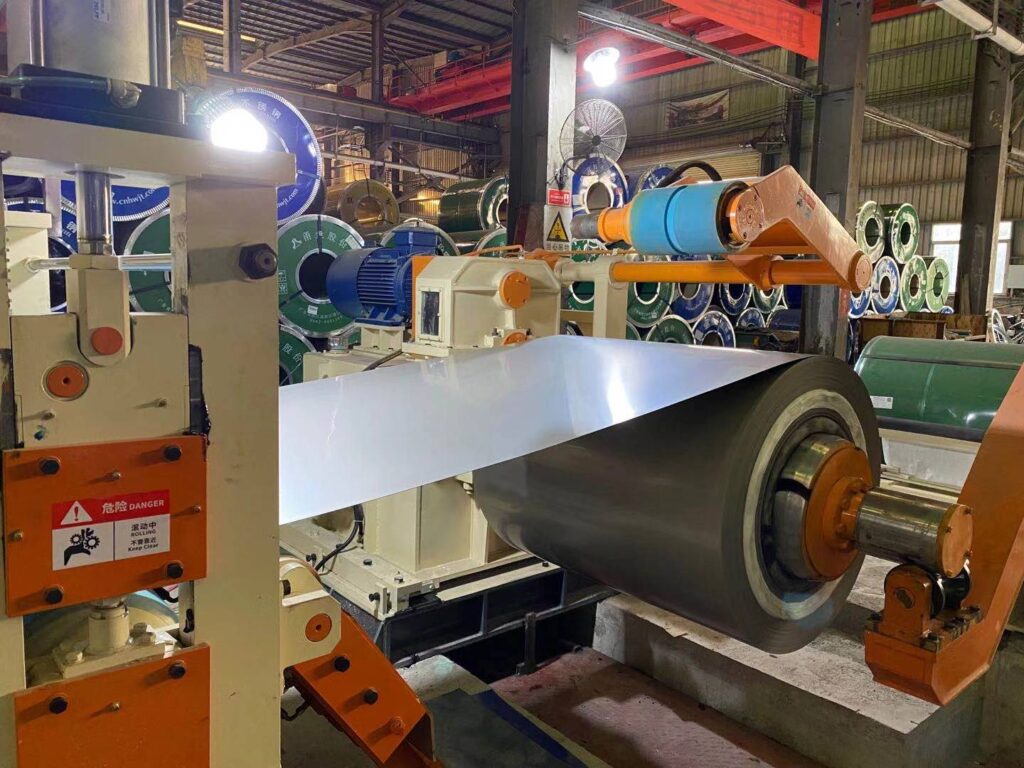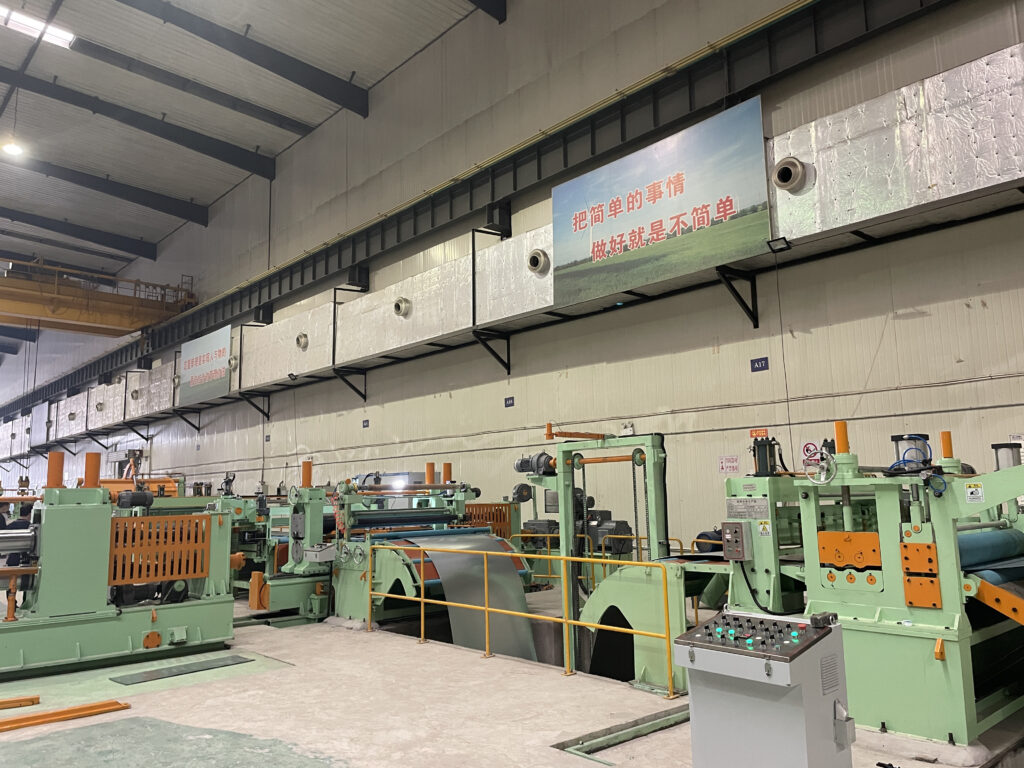Slitting vs. CTL Lines: 10-Year Lifecycle Cost & ROI Guide for MD Series Equipment
Choosing between a slitting line and a cut-to-length (CTL) line is a critical strategic decision for steel service centers aiming to enhance operational efficiency, material yield, and long-term profitability in 2025’s evolving market landscape. MaxDoMachine’s MD Series slitting lines set the industry benchmark with servo-driven rotary knives that deliver precision slitting at speeds up to 250 meters per minute while achieving exceptional material yields exceeding 96%. This is made possible through proprietary multi-zone tension controls and automated knife clearance adjustments that minimize scrap and maintain exacting strip dimensions—vital for sectors like automotive body panels, HVAC ductwork, and roll forming where material integrity directly impacts downstream processing and product quality.
Conversely, the MD Series CTL lines provide superior precision-cut flat sheets with dimensional tolerances of ±0.15mm, supported by advanced multi-roll leveling systems and high-accuracy length measurement. These lines excel in applications demanding flawless flatness and length consistency, such as aerospace components, appliance manufacturing, and structural steel fabrication, where surface quality and repeatability are non-negotiable. A comprehensive 10-year lifecycle cost and ROI analysis underscores the MD Series’ advantage: automated setup and quick-change tooling reduce downtime by up to 40%, while continuous coil-to-coil operation cuts energy consumption by 15-25% compared to conventional systems. Real-world implementations at leading steel service centers demonstrate up to 20% material savings and a 15% ROI improvement over a decade, delivering sustainable competitive edge and financial performance aligned with MaxDoMachine’s commitment to innovation and operational excellence.
Key Challenges in Choosing Between Slitting and CTL Lines
| Factor | Slitting Line | Cut-to-Length (CTL) Line |
|---|---|---|
| Material Utilization | >98% (Scrap <1.5%) | ~97.5% (Scrap ~2.5%) |
| Dimensional Precision | Width tolerance ±0.1 to ±0.3 mm | Length accuracy ±0.15 mm |
| Throughput Speed | Up to 250 m/min | 15–40 m/min |
| Changeover Time | 30–90 minutes | 15–45 minutes |
| Capital Investment (CapEx) | Higher per meter working width | Lower per meter working width |
| Operational Costs (OpEx) | Typically higher energy & maintenance requirements | Generally lower operating costs |
The decision between implementing a slitting line versus a cut-to-length (CTL) line in coil processing critically affects production efficiency, material utilization, and operational costs, demanding an informed evaluation tied closely to product requirements and manufacturing goals. Slitting lines boast exceptionally high material utilization rates, often exceeding 98% with scrap below 1.5%, due to their ability to convert wide coils into multiple narrow strips with tight width tolerances ranging from ±0.1 to ±0.3 mm. This precision makes them highly suitable for industries requiring narrow strip output like automotive parts, tube manufacturing, and roll forming. In contrast, CTL lines, while slightly less efficient in scrap management at around 2.5%, deliver superior flatness and length accuracy typically within ±0.15 mm, essential for high-quality sheet metal applications in construction, appliance manufacturing, and aerospace.
Throughput speed is a distinctive advantage of slitting lines, capable of processing strips at speeds up to 250 m/min, enabling high-volume, flexible production runs. CTL lines, optimized for flat sheets, operate at slower rates of 15 to 40 m/min but benefit from significantly faster changeovers—15 to 45 minutes versus 30 to 90 minutes for slitting—due to simpler tooling adjustments. This speed trade-off influences production scheduling and responsiveness to market demand shifts.
Financially, slitting lines entail higher capital expenditure per meter of working width, reflecting their complex rotary knife systems, multi-zone tension controls, and precision coil handling components. However, operating costs tend to be higher as well due to energy intensiveness and maintenance of intricate blade setups. CTL lines offer a more balanced capital investment and typically lower operational expenses, benefiting from simpler mechanical shearing and automated stacking technologies, which enhance overall cost-effectiveness in sheet-dominant production profiles.
Real-world case studies demonstrate that manufacturers with product portfolios comprising over 60% narrow strip output gain material yield and throughput benefits from slitting lines, while those focused on flat sheet production exceeding 75% find CTL lines better aligned with their precision and operational flexibility needs. Integrating automation in both systems—such as automated knife positioning, coil threading, and advanced tension control—further optimizes productivity and reduces labor dependency.
Selecting between slitting and CTL lines requires a nuanced understanding of production volume, product mix, precision demands, and cost structures. Aligning equipment choice with long-term operational goals and market trends ensures enhanced profitability and sustainable competitive positioning. Industry leaders increasingly prioritize hybrid solutions and advanced automation to adapt to evolving manufacturing landscapes where both narrow strips and flat sheets are in demand. These strategic decisions are foundational to achieving technical excellence and economic efficiency in metal coil processing today and beyond.
How to Systematically Evaluate Lifecycle Costs and ROI Over 10 Years?
Key Cost Factors to Consider
| Cost Element | Slitting Line | CTL Line |
|---|---|---|
| Capital Expenditure | $12,000 per meter width | $9,000 per meter width |
| Energy Consumption | 32 kWh per ton | 28 kWh per ton |
| Maintenance Cost | $1.20 per ton | $1.00 per ton |
| Scrap Cost | 1.5% material loss | 2.5% material loss |
| Changeover Duration | 30–90 minutes | 15–45 minutes |
Example Calculation (Based on 1,000 tons/month, $1,000/ton steel price)
- Slitting Line: Scrap cost at $180,000/year; Energy and maintenance drive further operating expenses, culminating in approximately $2.34 million over 10 years.
- CTL Line: Scrap cost rises to $300,000/year, leading to total 10-year operating and capital costs near $3.46 million.
Net savings favor slitting lines by approximately $1.12 million over a 10-year horizon, contingent on product mix and throughput.
Step-by-Step Guide to Implementing the Appropriate Line
| Phase | Duration | Key Activities | Key Outcomes |
|---|---|---|---|
| Production Needs Assessment | ~2 Weeks | Define product mix, precision, coil sizes, throughput | Clear production targets and equipment choice |
| Infrastructure Preparation | 4–6 Weeks | Foundations, utilities setup, safety & environmental compliance | Operationally ready production site |
| Equipment Installation & Commissioning | 3–4 Weeks | FAT, tension calibration, blade setup, safety interlocks | Validated and safe line performance |
| Training & SOP Development | ~80 Hours | Operator and maintenance training, develop SOP manuals | Skilled workforce, standardized maintenance |
| Ramp-Up & Optimization | 4–6 Weeks | Pilot runs, SPC data collection, dashboard monitoring | Stable, efficient production with continuous improvement |
Implementing a new slitting or cut-to-length (CTL) line requires meticulous planning and execution to align equipment capabilities with production goals. The process begins by thoroughly analyzing your production requirements. This involves defining the full spectrum of products you plan to manufacture, understanding the precision needed for each, and sizing the coils and throughput targets to set realistic performance expectations. It’s important to determine if your operations will focus primarily on producing narrow strips or flat sheets, as this fundamentally shapes your equipment choice.
Next, priming your facility to support the new line is critical. Site preparation extends beyond simply installing equipment—it incorporates building foundations engineered for dynamic loads, ensuring stable and clean power delivery, and setting up a reliable compressed air system. Safety systems must adhere strictly to OSHA and CE standards, incorporating protective barriers and emergency stops tailored to your operational environment. Additionally, addressing environmental factors such as dust extraction and noise reduction not only preserves equipment longevity but also fosters a safer and more comfortable workplace.
When the groundwork is laid, the installation phase unfolds. Factory Acceptance Tests (FATs) are conducted, validating that all machinery components meet design specifications. On-site commissioning then calibrates essential process controls like tension regulation and blade positioning, while integrating safety interlocks into your facility’s control architecture. This phase demands precision and cross-disciplinary collaboration, ensuring that theoretical equipment performance translates into practical productivity.
A robust training program follows, typically spanning 80 hours, tailored to operators and maintenance teams. Hands-on instruction covers coil threading protocols, maintaining consistent tension during operations, fine-tuning blade gaps, and safe operation procedures. Complementing training, a Standard Operating Procedure (SOP) manual codifies routine maintenance tasks such as regular knife inspections, lubrication frequency, and systematic calibration, empowering teams to sustain optimal equipment performance.
Finally, the ramp-up and optimization period fine-tunes the line under real production conditions. Pilot runs generate detailed data which guides adjustments to dimensions and scrap minimization efforts. Utilizing performance dashboards, managers track key metrics like Overall Equipment Effectiveness (OEE) and Mean Time Between Failure (MTBF), enabling proactive interventions. This iterative process elevates operational stability, throughput consistency, and yield quality, eventually transforming the new line from a project into a dependable production asset.
The Role of MaxdoMachine’s MD Series in Practical Solutions
| Model | Working Width (mm) | Thickness (mm) | Max Speed (m/min) | Total Power (kW) |
|---|---|---|---|---|
| MD-850 | 20–820 | 0.3–12 | 1–250 | 138.5 |
| MD-1350 | 300–1,300 | 0.3–12 | 1–250 | 318.5 |
| MD-1650 | 300–1,650 | 0.3–12 | 1–250 | 422.5 |
| MD-2200 | 300–2,150 | 0.3–12 | 1–250 | 422.5 |
Each model addresses distinct production profiles:
- MD-850 suits narrow band processing, ideal for applications requiring compact footprint and cost sensitivity.
- MD-1350 balances mid-range widths, delivering high precision with moderate capital expenditure.
- MD-1650 and MD-2200 support wide coil processing, tailored to high-volume steel service centers demanding maximal throughput and minimal scrap.
Real-World Application
Automotive Supplier Upgrading to MD-1350

Doubled throughput from 600 to 1,200 tons per month, achieving scrap rates under 1.2%. Payback period recorded at 18 months, driven by process optimization and reduced downtime.
North American Steel Service Center with MD-1650

Yield improvement of 20% realized, along with an ROI in under 14 months. The line supports a broad range of coil widths with consistent ±0.1 mm slit tolerances.
Asian Home Appliance Manufacturer Using MD-2200

Maintains equipment uptime at 85% OEE, ensuring reliable supply of wide slit coils and flat sheets with length and width tolerances within ±0.15 mm. Payback realized in three years due to energy efficiency and quality gains.
Troubleshooting and Best Maintenance Practices
- Blade Management: Regular inspection every 250 tons and gap adjustment between 0.05 and 0.15 mm extend blade life and ensure edge quality.
- Tension Control: Utilize multi-zone PLC-controlled tension systems, supplemented by ultrasonic feedback loops for entry and exit points to minimize edge waves and vibrations.
- Dimensional Stability: Verify incremental encoder precision and perform leveler roll alignment periodically to avoid dimensional drift.
- Preventive Maintenance: Quarterly lubrication of bearings and annual replacement of tension brake pads maintain uptime and performance consistency.
Industry Standards and Compliance Considerations
- Quality Assurance: ISO 9001:2015 certified quality management systems underpin commissioning and operation.
- Material Standards: Conformity with ASTM A568, JIS G3101, and DIN standards ensures processed steel quality meets customer and regulatory requirements.
- Safety Protocols: Machine guarding complies with OSHA B11.4 guidelines and CE safety directives for industrial equipment.
- Environmental Compliance: Noise reduction strategies and proper disposal of lubricants align with global environmental best practices.
Can existing lines be retrofitted to improve yield and precision?
Yes, retrofitting with advanced servo tension stands, vision-guided edge control systems, and upgraded PLCs can extend equipment life by 5–7 years while boosting reliability.
How can changeover times be minimized?
Standardizing blade cartridge designs, pre-setting coil guides, and using quick-release tension stands significantly reduce changeover durations.
What energy savings can be expected from modern slitting and CTL lines?
With regenerative drives and optimized tension control, operators can achieve up to 15% energy reduction compared to legacy equipment.
Conclusion and Next Steps
Balancing the decision between deploying slitting lines or cut-to-length (CTL) lines requires a deep understanding of the intricate trade-offs in production efficiency, precision, and long-term cost management. The MaxDoMachine MD Series epitomizes this balance by delivering industry-leading precision with dimensional tolerances as tight as ±0.1mm and maintaining material yield rates above 96% through advanced multi-zone tension controls and intelligent knife clearance technology. This engineering excellence translates into tangible benefits for sectors spanning automotive to construction, where the precision and yield directly impact downstream manufacturing quality and costs.
Field-proven across diverse operational contexts, the MD Series achieves up to 40% reduction in setup times and 15-25% lower energy consumption through automation and continuous coil-to-coil processing, driving a quantifiable ROI improvement of up to 15% over a 10-year lifecycle. MaxDoMachine’s commitment extends beyond hardware, providing data-driven consulting aligned with cutting-edge developments in automation, digitalization, and energy efficiency. This ensures every investment in MD Series equipment remains tightly aligned with evolving industry standards and dynamic market demands, thereby securing sustained operational excellence and cost leadership.




